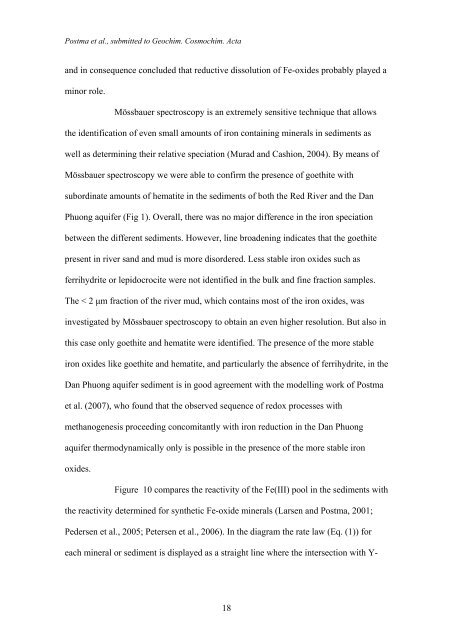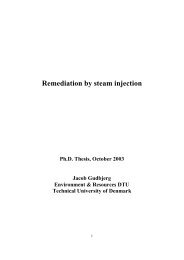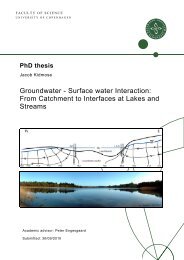Groundwater arsenic in the Red River delta, Vietnam ... - Fiva
Groundwater arsenic in the Red River delta, Vietnam ... - Fiva
Groundwater arsenic in the Red River delta, Vietnam ... - Fiva
Create successful ePaper yourself
Turn your PDF publications into a flip-book with our unique Google optimized e-Paper software.
Postma et al., submitted to Geochim. Cosmochim. Acta<br />
and <strong>in</strong> consequence concluded that reductive dissolution of Fe-oxides probably played a<br />
m<strong>in</strong>or role.<br />
Mössbauer spectroscopy is an extremely sensitive technique that allows<br />
<strong>the</strong> identification of even small amounts of iron conta<strong>in</strong><strong>in</strong>g m<strong>in</strong>erals <strong>in</strong> sediments as<br />
well as determ<strong>in</strong><strong>in</strong>g <strong>the</strong>ir relative speciation (Murad and Cashion, 2004). By means of<br />
Mössbauer spectroscopy we were able to confirm <strong>the</strong> presence of goethite with<br />
subord<strong>in</strong>ate amounts of hematite <strong>in</strong> <strong>the</strong> sediments of both <strong>the</strong> <strong>Red</strong> <strong>River</strong> and <strong>the</strong> Dan<br />
Phuong aquifer (Fig 1). Overall, <strong>the</strong>re was no major difference <strong>in</strong> <strong>the</strong> iron speciation<br />
between <strong>the</strong> different sediments. However, l<strong>in</strong>e broaden<strong>in</strong>g <strong>in</strong>dicates that <strong>the</strong> goethite<br />
present <strong>in</strong> river sand and mud is more disordered. Less stable iron oxides such as<br />
ferrihydrite or lepidocrocite were not identified <strong>in</strong> <strong>the</strong> bulk and f<strong>in</strong>e fraction samples.<br />
The < 2 m fraction of <strong>the</strong> river mud, which conta<strong>in</strong>s most of <strong>the</strong> iron oxides, was<br />
<strong>in</strong>vestigated by Mössbauer spectroscopy to obta<strong>in</strong> an even higher resolution. But also <strong>in</strong><br />
this case only goethite and hematite were identified. The presence of <strong>the</strong> more stable<br />
iron oxides like goethite and hematite, and particularly <strong>the</strong> absence of ferrihydrite, <strong>in</strong> <strong>the</strong><br />
Dan Phuong aquifer sediment is <strong>in</strong> good agreement with <strong>the</strong> modell<strong>in</strong>g work of Postma<br />
et al. (2007), who found that <strong>the</strong> observed sequence of redox processes with<br />
methanogenesis proceed<strong>in</strong>g concomitantly with iron reduction <strong>in</strong> <strong>the</strong> Dan Phuong<br />
aquifer <strong>the</strong>rmodynamically only is possible <strong>in</strong> <strong>the</strong> presence of <strong>the</strong> more stable iron<br />
oxides.<br />
Figure 10 compares <strong>the</strong> reactivity of <strong>the</strong> Fe(III) pool <strong>in</strong> <strong>the</strong> sediments with<br />
<strong>the</strong> reactivity determ<strong>in</strong>ed for syn<strong>the</strong>tic Fe-oxide m<strong>in</strong>erals (Larsen and Postma, 2001;<br />
Pedersen et al., 2005; Petersen et al., 2006). In <strong>the</strong> diagram <strong>the</strong> rate law (Eq. (1)) for<br />
each m<strong>in</strong>eral or sediment is displayed as a straight l<strong>in</strong>e where <strong>the</strong> <strong>in</strong>tersection with Y-<br />
18





